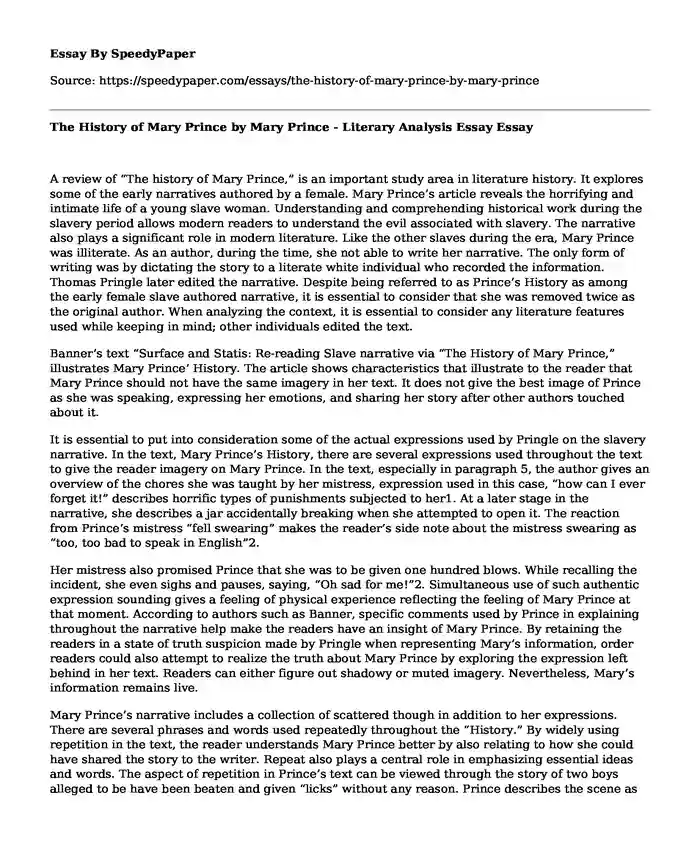
| Type of paper: | Literature review |
| Categories: | Literature Literature review |
| Pages: | 4 |
| Wordcount: | 896 words |
A review of “The history of Mary Prince,” is an important study area in literature history. It explores some of the early narratives authored by a female. Mary Prince’s article reveals the horrifying and intimate life of a young slave woman. Understanding and comprehending historical work during the slavery period allows modern readers to understand the evil associated with slavery. The narrative also plays a significant role in modern literature. Like the other slaves during the era, Mary Prince was illiterate. As an author, during the time, she not able to write her narrative. The only form of writing was by dictating the story to a literate white individual who recorded the information. Thomas Pringle later edited the narrative. Despite being referred to as Prince’s History as among the early female slave authored narrative, it is essential to consider that she was removed twice as the original author. When analyzing the context, it is essential to consider any literature features used while keeping in mind; other individuals edited the text.
Banner’s text “Surface and Statis: Re-reading Slave narrative via “The History of Mary Prince,” illustrates Mary Prince’ History. The article shows characteristics that illustrate to the reader that Mary Prince should not have the same imagery in her text. It does not give the best image of Prince as she was speaking, expressing her emotions, and sharing her story after other authors touched about it.
It is essential to put into consideration some of the actual expressions used by Pringle on the slavery narrative. In the text, Mary Prince’s History, there are several expressions used throughout the text to give the reader imagery on Mary Prince. In the text, especially in paragraph 5, the author gives an overview of the chores she was taught by her mistress, expression used in this case, “how can I ever forget it!” describes horrific types of punishments subjected to her1. At a later stage in the narrative, she describes a jar accidentally breaking when she attempted to open it. The reaction from Prince’s mistress “fell swearing” makes the reader’s side note about the mistress swearing as “too, too bad to speak in English”2.
Her mistress also promised Prince that she was to be given one hundred blows. While recalling the incident, she even sighs and pauses, saying, “Oh sad for me!”2. Simultaneous use of such authentic expression sounding gives a feeling of physical experience reflecting the feeling of Mary Prince at that moment. According to authors such as Banner, specific comments used by Prince in explaining throughout the narrative help make the readers have an insight of Mary Prince. By retaining the readers in a state of truth suspicion made by Pringle when representing Mary’s information, order readers could also attempt to realize the truth about Mary Prince by exploring the expression left behind in her text. Readers can either figure out shadowy or muted imagery. Nevertheless, Mary’s information remains live.
Mary Prince’s narrative includes a collection of scattered though in addition to her expressions. There are several phrases and words used repeatedly throughout the “History.” By widely using repetition in the text, the reader understands Mary Prince better by also relating to how she could have shared the story to the writer. Repeat also plays a central role in emphasizing essential ideas and words. The aspect of repetition in Prince’s text can be viewed through the story of two boys alleged to be have been beaten and given “licks” without any reason. Prince describes the scene as “their flesh ragged and raw with licks.--Lick--lick--they were never secure one moment from a blow, and their lives were passed in continual fear.” Later in the text, she describes how she was forced to return to her master. While referring to her father’s reaction, she repeatedly uses the word “loth” to emphasize how she refuted the returning idea, “Oh, I was loth, loth to go back.”
In Banner’s article, she states that there are at least twenty-six unique cases of either double or triple repetition in Mary Prince’s History. In Banner’s article, he states that repetition in the Prince’s text is highly coupled with traumatic slavery events such as family separation, forced labor, beatings, and illness sufferings. Repetition used in the book emphasizes on the feelings, personal ideologies, and actions stressed by the original author. Since recurrence can be compared to a song, the text can be termed to be completely authentic. Combining the Prince’s expressions and the repetition used gives the reader ability to feel Mary Prince’s voice despite her story being edited and changed by other authors.
Bibliography
Banner, Rachel. “Surface and Stasis: Re-reading Slave Narrative via ‘The History of Mary Prince.’” Callaloo, Vol. 36, No. 2 (Spring, 2013), pp. 298-311. The John Hopkins University Press. URL: https//www.jstor.org/stable/24264910
Prince, Mary. “The History of Mary Prince, A West Indian Slave.” The Longman Anthology of British Literature: The Romantics and Their Contemporaries: Fifth Edition. Damrosch, David, and Kevin J. H. Dettmar, editors. New York: Pearson, 2012. 303-311. Print.
Cite this page
The History of Mary Prince by Mary Prince - Literary Analysis Essay. (2023, Dec 26). Retrieved from https://speedypaper.com/essays/the-history-of-mary-prince-by-mary-prince
Request Removal
If you are the original author of this essay and no longer wish to have it published on the SpeedyPaper website, please click below to request its removal:
- Happy Moments Essay Sample
- Free Essay with a Literature Analysis of The Necklace and The Yellow Wallpaper
- Paper Example on George Orwell's Essay Politics and the English Language
- Free Essay on Walt Whitman's Song of Myself: Song of Democracy and Oneness of Mankind
- Free Essay Comprising Analysis of Pride and Prejudice by Jane Austen
- Essay Example: Literary Review of All's Well That Ends Well by William Shakespeare
- Speak by Laurie Halse Anderson. Essay Example
Popular categories




